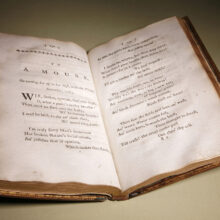A Brief History of the Saint Andrew’s Society of the State of New York
The Scottish diaspora in the United States is large – with more than 5 million people claiming Scottish ancestry – and generous, and the connections between Scotland and America extend back centuries. NTSUSA is proud to partner with some of the hundreds of Scottish-American associations and clubs across the country for the benefit of the National Trust for Scotland and its work to protect Scottish heritage and natural beauty today and for future generations. These include our corporate partners Scottish Heritage USA and ChicagoScots, as well as our fourteen Clan Partners.
This St Andrew’s Day, we are pleased to share a little bit about the history of the St Andrew’s Society of the State of New York, which, as the oldest charitable organization in New York, has supported Scots in need for more than two centuries. Members of the St Andrew’s Society of the State of New York have also been generous advocates for the National Trust for Scotland’s conservation mission, and all of us at NTSUSA are grateful.
A Brief History of the Saint Andrew’s Society of the State of New York
by Richard James Porter, 104th President
By the middle of the 18th century, there were more than 100,000 Scots and people of Scottish descent in Colonial America. From farmers and laborers to the younger sons of the nobility, Scots came from all parts of their native country, as well as Ulster, seeking opportunities in the New World. In cities ranging from Savannah in the South, in 1750, to Boston in the North, as early as 1657, Scots organized philanthropic and social groups to aid fellow Scots in need, building on the tradition of the church poor box. A secondary but important purpose was to provide social opportunities and business connections among the Scots.
The first such group in New York was established as the Scots Society of New-York in 1744, “from a compassionate Concern and Affection to their indigent countrymen.” The Society folded around 1753, but the need for a philanthropy to assist Scots in need, particularly widows and orphans, continued unabated. On November 19, 1756, a group of 45 men established The Saint Andrew’s Society of New-York in the Province of New-York, “for the relief of Natives of Scotland and their Descendants who might be in Want or Distress, and to promote Social Intercourse among its members.” Alms were not to be given to those whose indigence was the result of drunkenness.
Philip Livingston was elected the first President. Livingston would become one of the three early members of the Society to sign the Declaration of Independence, the other two being Lewis Morris and Rev. John Witherspoon, the latter an early president and key figure in the development of the College of New Jersey, known today as Princeton University.
All was not serene in the early years of the Society. Presbyterians and Anglicans were often at odds, and the years of the American Revolution saw the organization split between Tories and Patriots. By 1784, peace in the nation as well as in the Saint Andrew’s Society was restored.
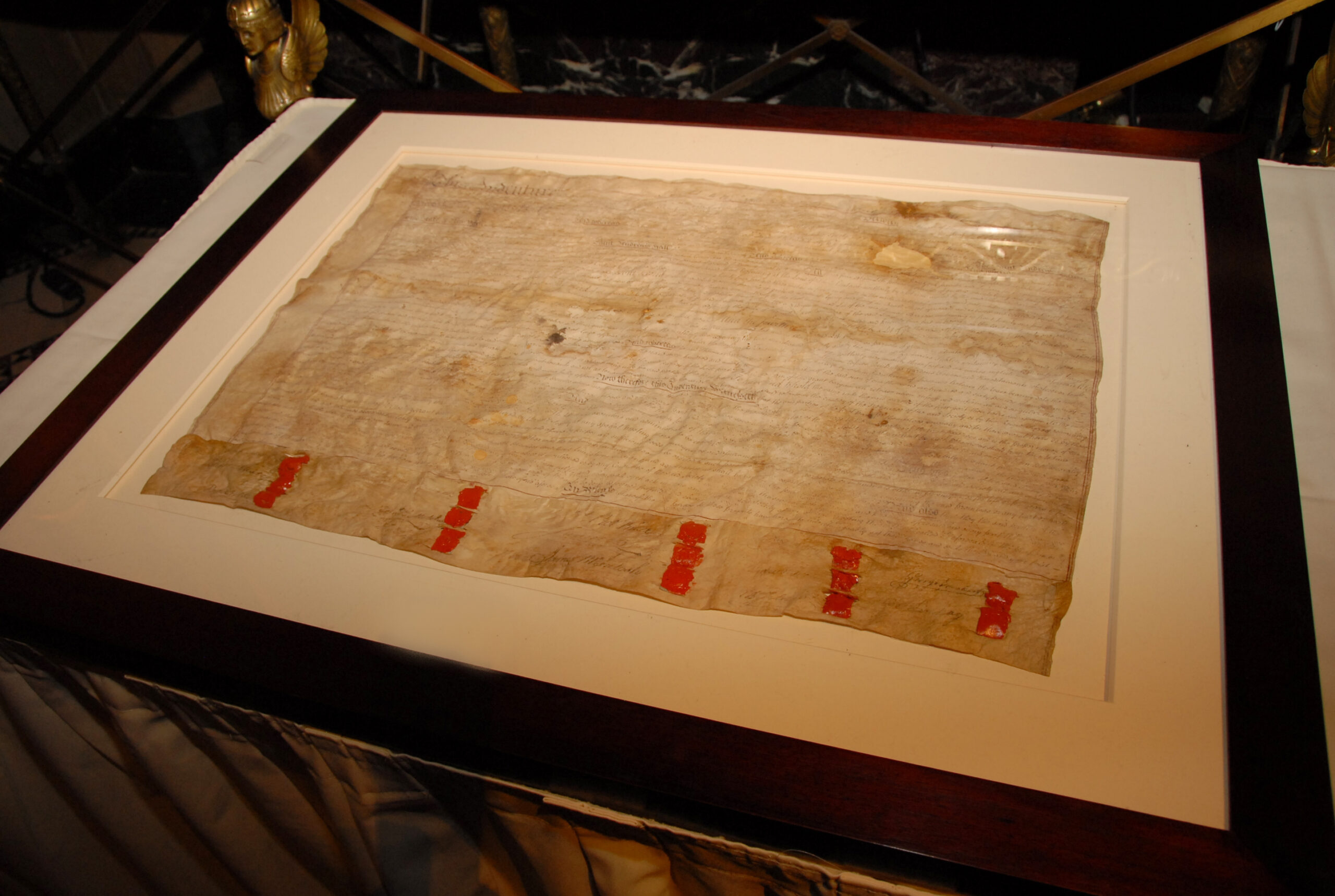
The original deed for the purchase of lots in 1791 was to become the New York Stock Exchange.
At a reorganizational meeting, the Society’s name was changed to its present form, The Saint Andrew’s Society of the State of New York. It was decided about this time that the Society should have a permanent home. A subscription drive was held, and lots were purchased. A small ledger from the year 1787 in which member Alexander Hamilton placed his signature, along with a pledge of £15, remains in the Society’s archives. Another prized possession is the original deed for the purchase of the lots in 1791. Unfortunately, plans for a “Saint Andrew’s Hall” were abandoned and the lots were sold (at a profit of course) in 1794. The New York Stock Exchange occupies those same lots today.
A full-time Almoner was hired in 1841 to ensure that the Society’s philanthropy was distributed with due care. The Centennial Celebration held at the fashionable Metropolitan Hotel on Saint Andrew’s Day 1856 was another grand affair covered by the various New York papers. Ladies were seated in the gallery overlooking the men on the main floor. Women would continue either to be excluded from the annual banquets or seated separately until 1991. Many other Saint Andrew’s Societies and their events remain exclusively male to this day.
Nearly all early records of the Society were destroyed by fire in 1834, but the surviving membership applications from the 19th and early 20th centuries reveal an interesting demographic. Although the founders of the Society would appear all to have been men of wealth, or at least from the professional class, many men admitted into the Society between 1835 and the early 20th century, when membership was at its height, were masons, carpenters, builders, or clerks. Even the legendary Andrew Carnegie listed his profession as “Iron Master” on his application in 1871.
Carnegie would go on to serve in several leadership positions in the Society, including President from 1899 to 1902. In 1901 Carnegie was honored by having no less a speaker than Mark Twain at the Annual Banquet. That same year he gave the Society $100,000, followed by a bequest of another $100,000 when he died in 1922. These would remain that largest monetary gifts to the Society for nearly 100 years.
The 20th century began auspiciously with a huge Sesquicentennial celebration in 1906. The New York press again covered the event extensively, commenting on the pageantry and the notable personages in attendance. Carnegie donated a large, silver loving cup that has remained part of the Annual Banquet ritual ever since. In 1916, William MacBean, a native Scot, became the first official Historian of the Society. His extraordinary work and dedication resulted in several volumes, without which this present historical summary could not have been written.
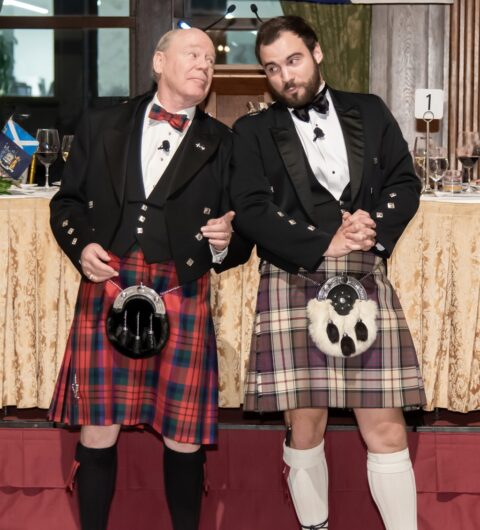
Richard Porter and Jake Robertson, who received a Society Scholarship to study musical theater at the Royal Conservatoire in Glasgow, perform a tribute to music hall and vaudeville legend Sir Harry Lauder at the 263rd Annual Banquet in 2019.
World Wars I and II, as well as the Great Depression, disrupted the Society’s social activities. Society members would be killed in both wars, as they had in the Civil War, but the Society’s essential work of providing relief to Scots and descendants of Scots in need continued, and special funds were established to support the war efforts.
Scots have traditionally been advocates for education. Members of the Saint Andrew’s Society were involved in the founding of both Columbia and Princeton Universities, one primarily Anglican and the other Presbyterian; however, the granting of scholarships did not become part of the Society’s mission until the 1950s, with the establishment of the Scholarship Fund in 1956, and the awarding of the first scholarship in 1960. Today, the Society offers five scholarships, two to American students seeking graduate degrees in Scottish universities, and two to Scottish students seeking graduate degrees in the United States. In 2006, Margaret Macmillan, the Society’s first female member, endowed the Agnes and Margaret Macmillan Scholarship enabling the Society to send a third student to study in Scotland.
The 21st century has again been the best of times and the worst of times. With the purchase of its present offices at 150 East 55th Street, the Society began the new millennium in its first non-rented space in almost 250 years. Hardly a year later, the terrorist attack on the Twin Towers took the lives of three young members: James Leslie Crawford, Andrew Marshall King, and Derek Ogilvie Seward. A true hero of that infamous day was Welles Remy Crowther, the son of the late Jeffrey Crowther, a longtime member of the Society. Known in the media as “the man in the red bandana,” Crowther worked on the 104th floor of the South Tower. He is credited with saving hundreds of lives before losing his own.
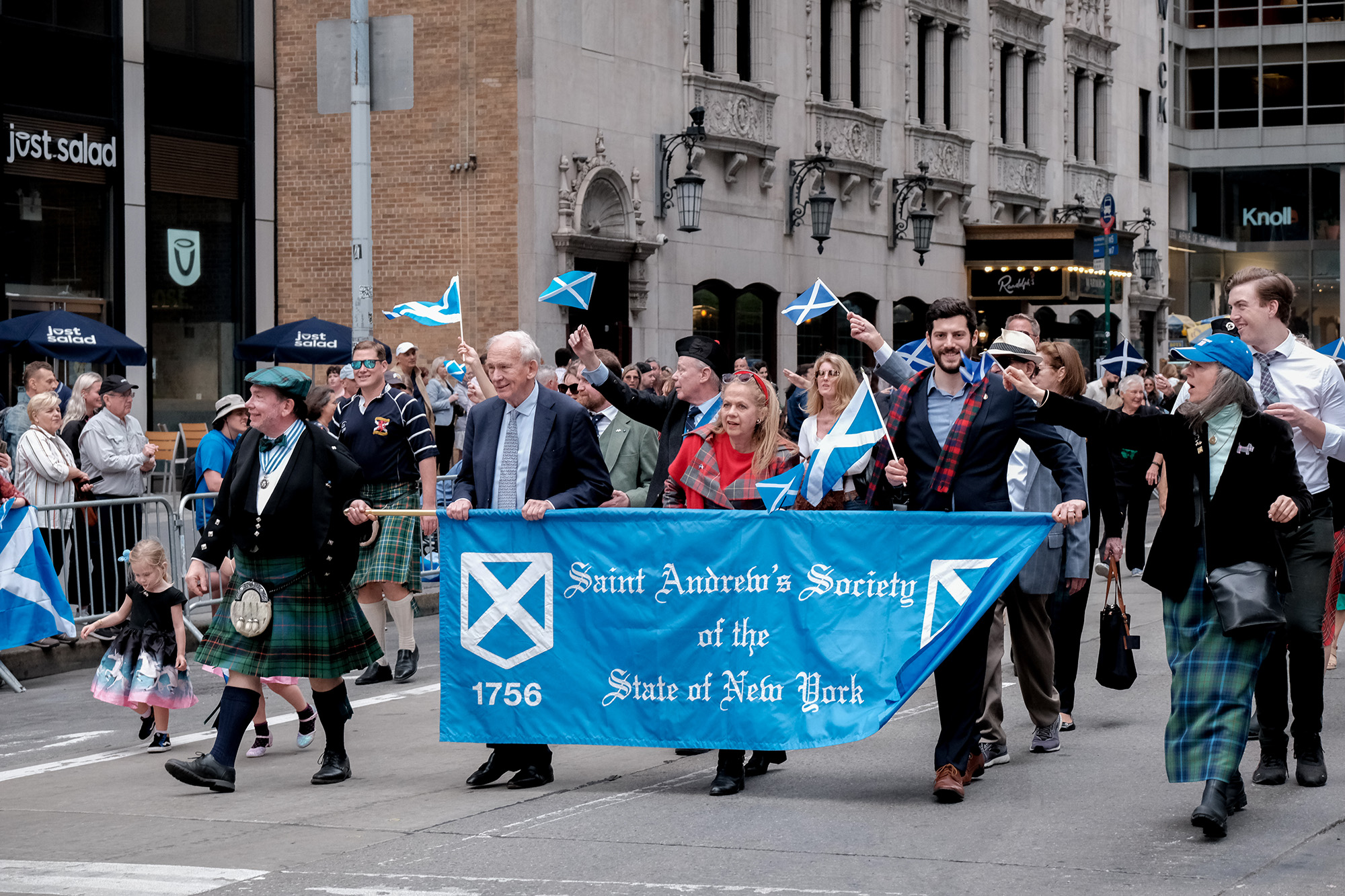
NY Tartan Day Parade, 2022. As the oldest Scottish organization in NY, and one of the founders of NY Tartan Week, the Society always leads the parade, just behind the Grand Marshall.
In 2002, four years after the US Senate established April 6 as National Tartan Day, the Saint Andrew’s Society became a founding member of New York Tartan Week. As the oldest Scottish organization in the city, the Society leads the annual Tartan Day parade, proudly displaying the Society banner, and hosts the official Tartan Day Cocktail Party. The Society’s annual Kirkin’ o’ the Tartan and Brunch has become another highlight of Tartan Week, anticipated, and attended by many, including representatives from the Scottish Government.
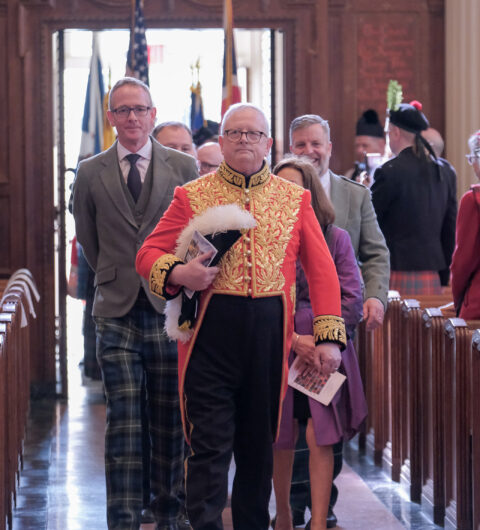
The Lord Lyon King of Arms, John Lamont Under-Secretary of State for Scotland, Alison Johnstone Presiding Officer of the Scottish Parliament, and Angus Robertson Cabinet Secretary for the Constitution External Affairs and Culture, lead the procession at the annual Kirkin’ o’ the Tartan in 2023.
The year 2006 was a major milestone with the celebration of the Society’s 250th Anniversary. The Lord Lyon King of Arms granted the Society an official Coat of Arms, and a unique Society tartan, designed by member Hamish Ian Carruthers MBE, was registered with the Scottish tartan Authority.
Four years later, the Society changed its Constitution to allow female members, whose admission has brought new life and energy to the organization. Women have already served as Chairs of the Board of Managers, and as Chairs of the Almoner’s Committee. Dr. Doreen Wray Roth was elected Second Vice-President in 2022, which means that she will become the first woman president of the Saint Andrew’s Society of the State of New York in 2026.
A new philanthropic endeavor was established in 2013 when the Society began an ongoing program to support the New York Presbyterian-Komansky Children’s Hospital and the Royal Hospital for Children in Glasgow. This effort not only provides financial support but fosters a collegial relationship and communication between the staffs of the two hospitals.
In 2016, in remembrance of Twain’s appearance at the banquet in 1901, the Society created the Mark Twain Award to honor a distinguished Scot or Scottish American. The first recipient was the Scots journalist and BBC presenter, Kirsty Wark. The honoree in 2021 was Gary Maclean, the National Chef of Scotland.
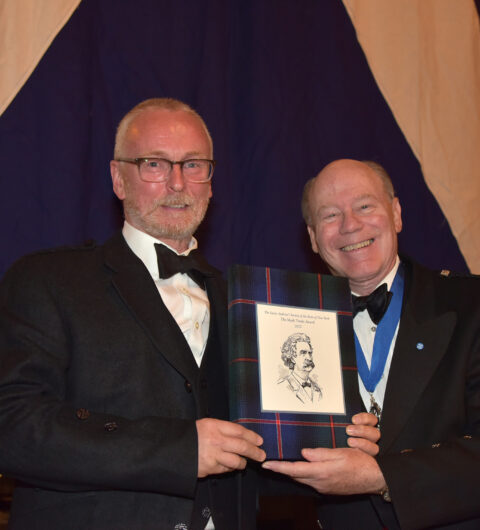
Richard James Porter, 104th President, presenting the Society’s Mark Twain Award for 2022 to internationally renowned sculptor and NTSUSA Board Member Andy Scott
In 2022 the award was presented to sculptor and National Trust for Scotland Foundation USA Board member Andy Scott, creator of the magnificent “Kelpies” near Edinburgh. Our honoree in 2023 will be Scottish actor Phyllis Logan, beloved for her role as Mrs. Hughes in the hugely popular PBS series, “Downton Abbey.” The Saint Andrew’s Society’s most recent challenge was the Covid 19 Pandemic. Its most recent triumph was its response to it. The work of the Almoner’s Committee went smoothly, with surprisingly few new pandemic related demands on its resources.
The dedicated and determined office staff moved almost seamlessly into working remotely, and most remarkably, the Society’s 264th Celebration of Saint Andrew’s Day, held via Zoom, marked the most successful in the Society’s history in raising funds for its philanthropic mission. In that same Zoom celebration, Helen Sayles, CBE, Chair of the National Trust for Scotland Foundation USA Board, graciously received the Mark Twain Award for 2020.
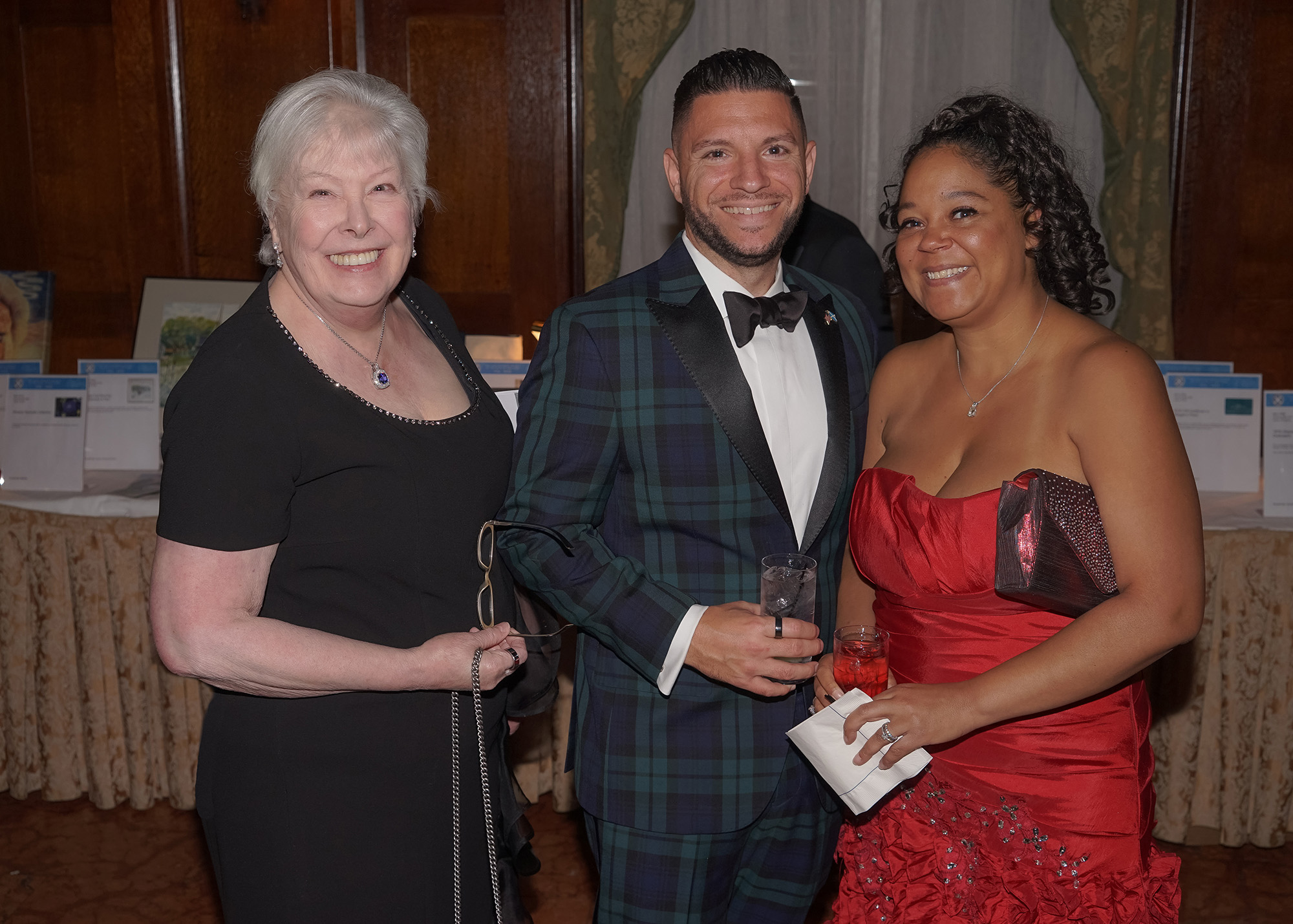
The Society’s 2020 Mark Twain Award recipient and NTSUSA Chair Helen Sayles CBE with her daughter Leila Rovito and son-in-law Vinny Rovito at the Society’s 266th Annual Banquet in 2022.
Much is owed by many to those 45 Scots who 266 years ago, with typical Scottish pride, grit, and sense of purpose, created a Society dedicated to the aid of those in want or distress, and social interaction among people of Scottish descent. The challenge is to ensure that their vision and good work continue for at least as many years to come.

